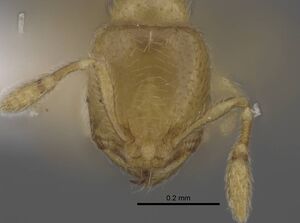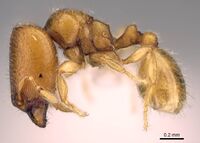Carebara berivelo
| Carebara berivelo | |
|---|---|

| |
| Scientific classification | |
| Kingdom: | Animalia |
| Phylum: | Arthropoda |
| Class: | Insecta |
| Order: | Hymenoptera |
| Family: | Formicidae |
| Subfamily: | Myrmicinae |
| Tribe: | Crematogastrini |
| Genus: | Carebara |
| Species: | C. berivelo |
| Binomial name | |
| Carebara berivelo Azorsa & Fisher, 2018 | |
A forest species that has been collected using maxi-Winkler and pitfall traps. Individuals and colonies were found in sifted litter, leaf mold, and rotten wood.
Identification
Azorsa and Fisher (2018) - Antennae ten-segmented. Major: Head subrectangular, posterior margin medially concave, and posterolateral corners rounded; promesonotum flat in profile view, quite similar to C. bara, but the propodeum of C. berivelo has a pair of acute teeth, dorsum of propodeum is flat; combined outline of dorsal surface of peduncle and anterior face of node slightly medially concave, anterodorsal corner convex, posterior face of node vertical and nearly straight, dorsum slightly convex. Minor: Head slightly longer than wide, posterior margin nearly straight; promesonotum weakly convex, similar to C. bara but easily differentiated by the presence of a pair of small acute teeth on the propodeum, anterodorsal corner moderately convex, dorsum flat and declining posteriorly; gaster with decumbent hairs. There are no intermediate castes.
Carebara berivelo is endemic to the north of Madagascar. It can be confused with Carebara bara but can be separated from that species by the propodeum, which is armed with a pair of small triangular teeth, while C. bara is unarmed in major workers, and armed with a small angulate tooth in minor workers. Both species occur in sympatry in the north of Madagascar. Five additional species are present in this area (Carebara grandidieri, Carebara kabosy, Carebara malagasy, Carebara salegi, and Carebara tana).
Keys including this Species
Distribution
Azorsa and Fisher (2018) - Known from north Madagascar littoral rainforest and tropical dry forest. Collections have been made at 90 m, 180 m, and 325 m.
Latitudinal Distribution Pattern
Latitudinal Range: -12.25889° to -14.34832°.
| North Temperate |
North Subtropical |
Tropical | South Subtropical |
South Temperate |
- Source: AntMaps
Distribution based on Regional Taxon Lists
Malagasy Region: Madagascar (type locality).
Distribution based on AntMaps
Distribution based on AntWeb specimens
Check data from AntWeb
Countries Occupied
| Number of countries occupied by this species based on AntWiki Regional Taxon Lists. In general, fewer countries occupied indicates a narrower range, while more countries indicates a more widespread species. |

|
Estimated Abundance
| Relative abundance based on number of AntMaps records per species (this species within the purple bar). Fewer records (to the left) indicates a less abundant/encountered species while more records (to the right) indicates more abundant/encountered species. |

|
Biology
Castes
Images from AntWeb
  
| |
| Paratype of Carebara berivelo. Worker. Specimen code casent0438192. Photographer Frank Azorsa, uploaded by California Academy of Sciences. | Owned by CAS, San Francisco, CA, USA. |
Nomenclature
The following information is derived from Barry Bolton's Online Catalogue of the Ants of the World.
- berivelo. Carebara berivelo Azorsa & Fisher, 2018: 38, figs. 33, 68 (s.w.) MADAGASCAR.
- Type-material: holotype major worker, 14 paratype major workers, 22 paratype minor workers.
- Type-locality: holotype Madagascar: Antsiranano, Rés. Spéc. d’Ambre, 3.5 km. 235° SW Sakaramy, -12.46889, 49.24217, 325 m., 26-31.i.2001, BLF02654, tropical dry forest (B.L. Fisher, C.E. Griswold, et al.); paratypes: 10 major workers, 20 minor workers with same data, 3 major workers, 2 minor workers with same data but BLF2655, pitfall trap, 1 major worker Antsiranana, Montagne des Français, 7.2 km. 142° SE Antsiranana (= Diego Suarez), -12.32278, 49.33817, 180 m., 22-28.ii.2001, BLF03128, tropical dry forest (B.L. Fisher, C.E. Griswold, et al.).
- Type-depositories: CASC (holotype); BMNH, CASC, MCZC, MHNG, NHMB (paratypes).
- Distribution: Madagascar.
Unless otherwise noted the text for the remainder of this section is reported from the publication that includes the original description.
Description
Worker
Major. (n=11): HL 0.56–0.71 (0.71); HW 0.42–0.54 (0.53); SL 0.24–0.27 (0.27); ML 0.10–0.15 (0.15); EL 0.02–0.04 (0.04); EM 0.15–0.20 (0.20); HD 0.31–0.39 (0.39); WL 0.47–0.60 (0.60); PSL 0.06–0.09 (0.08); PW 0.28–0.37 (0.37); MFL 0.31–0.37 (0.35); MFW 0.07–0.10 (0.09); MTL 0.22–0.28 (0.28); PTL 0.16–0.25 (0.25); PNL 0.07–0.11 (0.11); PTH 0.13–0.17 (0.17); PTW 0.12–0.17 (0.17); PPL 0.11–0.14 (0.14); PPNL 0.10–0.13 (0.12); PPH 0.11–0.16 (0.16); PPW 0.15–0.20 (0.20); GL 0.46–0.86 (0.57); GW 0.40–0.55 (0.54), CI 73–77 (75); MI 16–21 (21); SI 37–43 (38); MLI 65–76 (66); PPLI 56–72 (56); PPI 118–143 (118); PSI 13–18 (15).
Head longer than wide (CI 73–77), in full-face view nearly subrectangular, about 1.3 times longer than wide. Posterior margin of head medially concave, posterolateral corners rounded, lateral margins nearly straight. Mandibles with five teeth. Anterior margin of clypeus slightly concave medially and laterally convex. Antennae with ten segments. Scapes short (HL 0.56–0.71, SL 0.24–0.27, SI 37–43) not surpassing cephalic midlength. Eyes present, consisting of three ommatidia (EL 0.02–0.04). Supraclypeal area as a triangular depression but poorly defined.
In profile, posterolateral corner of head with (larger major workers) or without (smaller major workers) a small, obtuse tooth resembling a horn. Promesonotum high and convex, metanotal groove present. Propodeum about 1.4 times higher than long, dorsal face of propodeum flat, declining posteriorly, posterodorsal corner of propodeum with a pair of short, triangular teeth, declivity of propodeum flat to slightly concave with thin lateral laminae connecting propodeal lobe. Propodeal lobes triangular with blunt apices. Propodeal spiracle rounded and situated slightly above mid-height of sclerite, and beyond mid-length of sclerite, by about half the diameter of the spiracle, distance from propodeal spiracle to posterodorsal corner of propodeum more than twice but less than three times the diameter of the spiracle (PSL 0.06–0.09), and distance to declivity same as the diameter of the spiracle. In dorsal view, promesonotum about as long as wide, anterior margin and sides rounded; sides of propodeum nearly straight.
Petiole longer than high (PTH 0.13–0.17, PTL 0.16–0.25) with a relatively short peduncle, ventral face nearly flat but slightly convex in the middle. Combined outline of dorsal surface of peduncle and anterior face of node medially concave, posterior margin nearly vertical and slightly convex, anterodorsal corner convex, and posterodorsal corner rounded, dorsum rounded. Subpetiolar process small, acutely produced, and at about the same as the diameter of the propodeal spiracle. Postpetiolar node rounded and lower than petiolar node. In dorsal view, postpetiolar node slightly wider than petiolar node (PPW 0.16–0.23, PTW 0.12–0.17), petiolar node wider than long (PTW 0.12–0.17, PNL 0.07–0.11), anterior and posterior margins of petiole nearly straight, anterior margin of postpetiole concave and posterior margin straight, sides rounded in petiole and postpetiole.
Dorsal surface of mandibles, clypeus and frons smooth and shiny, with scattered piligerous punctae on head and mandibles. Dorsolateral faces of head with fine longitudinal rugae, reticulate-rugose sculpture near posterior margin of head, gena with longitudinal carinae, weakly marked rugae on frontal lobes. In profile, posterolateral portion of cephalic dorsum smooth and shiny. Sides of pronotum with fine longitudinal and parallel striations, smooth and shiny medially and dorsally, anepisternum smooth and shiny, katepisternum, metapleuron, propodeum, propodeal lobes, petiole and ventral face of postpetiole areolate-rugose. In dorsal view, promesonotum smooth and shiny except for anterior margin which is weakly areolate, propodeum, declivity and petiole areolate-rugose, postpetiole and gaster smooth and shiny.
Lateral margins and posterior margin of head with suberect hairs, and sparse short decumbent hairs. Scapes with appressed hairs. Outer margin of mandible with sparse decumbent hairs. Mesosoma with suberect hairs. Petiole, postpetiole and gaster with short decumbent hairs and sparse long suberect hairs. Tibia with sparse appressed hairs. Color yellowish ferruginous, antennae, legs and parts of gaster, slightly lighter.
Minor. (n=5): HL 0.35–0.36; HW 0.30– 0.33; SL 0.20–0.23; ML 0.08–0.10; EL 0.01–0.02; EM 0.10–0.11; HD 0.20–0.23; WL 0.33–0.38; PSL 0.04–0.05; PW 0.19–0.21; MFL 0.20–0.24, MFW 0.05–0.06; MTL 0.16–0.18; PTL 0.11–0.13; PNL 0.06–0.07; PTH 0.09–0.10; PTW 0.08; PPL 0.07–0.08; PPNL 0.06–0.07; PPH 0.07–0.08; PPW 0.09–0.11; GL 0.27–0.36; GW 0.21–0.27; CI 84–92; MI 23–28; SI 57–64; MLI 67–73; PPLI 58–64; PPI 113–138; PSI 12–15.
Head longer than wide (CI 84–92), in full-face view weakly subrectangular, about 1.2 times longer than wide, and slightly narrowed anteriorly. Posterior margin of head slightly concave in the middle, posterolateral corners convex, lateral margins convex. Mandibles with five teeth. Anterior margin of clypeus more or less straight, sides with small, angulate, forwardly directed teeth. Antennae with ten segments. Scape fails to reach the posterior margin of head (HL 0.35–0.36, SL 0.20–0.23, SI 57–64). Eyes present, consisting of one ommatidium (EL 0.01–0.02). Supraclypeal area triangular but poorly defined and appears as a small oblong depression.
In profile view, promesonotum weakly convex, metanotal groove deeply impressed. Propodeum about 1.45 times higher than long, dorsal face nearly flat and declining posteriorly, anterodorsal corner convex, posterodorsal corners each armed with a triangular tooth, declivity of propodeum concave and with thin lateral laminae. Propodeal lobes triangular. Propodeal spiracle rounded and situated slightly above mid-height of sclerite by about half the diameter of the spiracle, and beyond mid-length of sclerite by about 1.5 times the diameter of the spiracle, distance from propodeal spiracle to posterodorsal corner of propodeum barely larger than the diameter of the spiracle (PSL 0.04–0.05), and distance to declivity less than half the diameter of the spiracle. In dorsal view, promesonotum longer than wide, anterior margin weakly convex, sides convex and narrowed posteriorly; propodeum about as long as wide, sides convex.
Petiole approximately as high as long (PTH 0.09–0.10, PTL 0.11–0.13) with a short peduncle, ventral face convex in the middle. Combined outline of dorsal surface of peduncle and anterior face of node nearly straight, sometimes weakly concave, posterior margin slightly convex, dorsum weakly convex. Subpetiolar process reduced to a small convexity. Postpetiolar node strongly convex and slightly lower than petiolar node, postpetiolar ventral process present, small and convex. In dorsal view, postpetiolar node wider than petiolar node (PPW 0.09–0.11, PTW 0.08), petiolar node wider than long (PTW 0.08, PNL 0.06–0.07), anterior and posterior margins of petiole nearly straight, anterior margin of postpetiole concave and posterior margin nearly straight, sides of petiole slightly convex and sides of postpetiole strongly convex.
Dorsal surface of mandibles, clypeus and frons smooth and shiny, with scattered piligerous punctae on head and mandibles. Dorsolateral faces of head, gena and frontal lobes with fine longitudinal rugae. Mesosoma smooth and shiny, except for katepisternum and posterior border of anepisternum (areolate), metapleuron (finely areolate), and dorsum of propodeum (finely areolate). Petiole and ventral face of postpetiole areolate. In dorsal view, promesonotum postpetiole and gaster smoth and shiny, propodeum and petiole areolate.
Lateral margins and posterior margin of head with subdecumbent hairs. Scapes with abundant decumbent hairs. Outer margin of mandible with decumbent and appressed hairs. Mesosoma with suberect hairs. Petiole, postpetiole, and gaster with subdecumbent to decumbent hairs, and some longer and subdecumbent hairs. Tibia with appressed hairs. Color yellowish ferruginous.
Type Material
Holotype. (major worker), MADAGASCAR, Antsiranana, Réserve Spéciale d’Ambre, 3.5 km 235° SW Sakaramy, -12.46889, 49.24217, 325 m, tropical dry forest, 26–31.i.2001, (Fisher, Griswold et al.). Collection code BLF02654, (California Academy of Sciences: CASENT0438188). Paratypes: (10 major workers and 20 minor workers), with same data as holotype, 6 major workers (The Natural History Museum: CASENT0438182, CASC: CASENT0438184, CASENT0438198, CASENT0439906, CASENT0438197, Museum of Comparative Zoology: CASENT0438281), and 18 minor workers (BMNH: CASENT0438185, CASC: CASENT0438222, CASENT0438221, CASENT0438133, CASENT0438209, CASENT0438219, CASENT0438131, CASENT0439901, CASENT0438192, CASENT0438220, CASENT0438194, CASENT0438193, CASENT0438206, CASENT0438190, CASENT0438204, MCZ: CASENT0438196, Musee d'Histoire Naturelle Genève: CASENT0438187, Naturhistorisches Museum, Basel: CASENT0439903). 3 major workers and 2 minor workers with same data as holotype except collected from pitfall trap and collection code BLF2655, 3 major workers (CASC: CASENT0439911, MHNG: CASENT0439915, NHMB: CASENT0439914), 2 minor workers (CASC: CASENT0439917, CASENT0439916). 1 major worker with different data from holotype: Madagascar, Antsiranana, Montagne des Français, 7.2 km 142° SE Antsiranana, (=Diego Suarez), -12.32278, 49.33817, 180 m, tropical dry forest, 22–28.ii.2001, (Fisher, Griswold et al.). Collection code BLF03128, (CASC: CASENT0460943).

